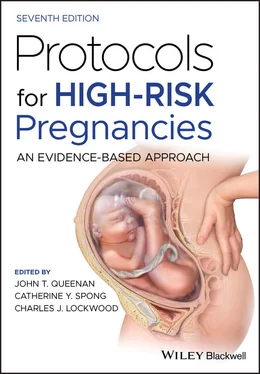Blood flow velocity waveforms obtained by pulsed‐wave Doppler velocimetry change in any given fetal vessel across gestation. In the umbilical artery of a normal pregnancy, there is a progressive increase in diastolic flow velocity across gestation, which reflects a decrease in the resistance within the placenta. One characteristic of FGR due to uteroplacental insufficiency is an increase in blood flow resistance within the placenta, which can be detected by Doppler velocimetry upstream in the umbilical arteries. Approximately 40% of cardiac output is directed toward the placenta via the umbilical artery. Thus, as placental disease progresses and blood flow resistance increases, fetal hypoxia may be reflected in the central nervous system (CNS) and the heart is subject to increased workload (afterload). Prior to significant cardiac dysfunction becoming apparent, abnormalities arise in the “prechordial” venous circulation (inferior vena cava, DV, and hepatic veins) in up to 70% of preterm, severely FGR fetuses. Further, recent data from a randomized clinical trial suggest that use of DV to manage early‐onset FGR may reduce long‐term neurodevelopmental delay. Use of Doppler velocimetry in the management of FGR is further discussed in Protocol 41.
As previously mentioned, fetal anemia resulting from maternal alloimmunization (except anti‐Kell) was historically detected by amniocentesis and assessment of the ΔOD450 and then confirmed by fetal blood sampling. Assessment of the MCA PSV has replaced the ΔOD450 as the gold standard test for fetal anemia. The MCA PSV has greater sensitivity for moderate to severe anemia than does the ΔOD450. Moreover, the ΔOD450 is not useful in Kell sensitization because fetal anemia in this condition is caused by bone marrow suppression rather than hemolysis and thus does not lead to RBC breakdown products in the amniotic fluid normally detected by the ΔOD450.
One of the resultant pathophysiological features present in Rh disease is a reduction in the viscosity of the fetal blood, which is secondary to a lower hematocrit. This results in an increase in the velocity of blood flow, which can be detected by pulsed‐wave Doppler velocimetry. One of the vessels branching off the circle of Willis is the MCA, which lends itself to interrogation by Doppler because of its location and because the paired middle cerebral arteries carry 80% of the cerebral blood flow. The MCA is first identified with the use of color flow Doppler. With an angle of insonation of 0° (or less than 30° with angle correction), pulse‐wave Doppler velocimetry is used to obtain the flow velocity waveform. From the flow velocity waveform, one can determine the PSV across serial peaks of the systolic component of the flow velocity waveform profile and obtain a mean systolic peak velocity of the MCA flow waveform. Nomograms are available for PSV in the MCA across gestation. Web‐based MCA PSV multiples of the median (MoM) calculators for a given gestational age are also available at perinatology.com.
When the MCA PSV surpasses the threshold of 1.55 MoM, there is a high risk of moderate to severe anemia in the fetus. The original report on this technique for assessing fetal anemia showed that a cut‐off 1.55 MoM has a sensitivity of 100% and a negative predictive value of 100% for moderate to severe anemia. Subsequent studies have shown similar favorable performance characteristics of this screening test. Once this value is surpassed, the fetus can undergo blood sampling to determine the actual fetal hematocrit and determine if a transfusion is necessary. Using Doppler to assess the MCA PSV and identifying anemia in the fetus in this fashion avoids the standard invasive procedural risks of amniocentesis (needed for the ΔOD450) including exacerbation of the Rh sensitization. The MCA PSV measurement has also been used to guide management in cases of anemia due to infections such as parvovirus, loss of a co‐twin in monochorionic pregnancies, and in TAPS.
Management
Congenital heart disease and arrhythmia
Several clinical scenarios may warrant fetal echocardiography, which is discussed in more detail in Protocol 6. The ideal time to obtain a fetal echocardiogram is between 18 and 22 weeks of gestation; however, there are several specialized perinatal centers performing this in the first trimester. Counseling and management of the patient with a congenital heart defect involves a variety of steps that include defining the type and severity of cardiac lesion, consideration of the patient’s moral and religious disposition, genetic testing of the fetus (e.g., karyotype, chromosomal microarray, 22Q testing, etc.), and the presence of extracardiac abnormalities. In many instances, one of the most important things to determine in a fetus with congenital heart disease is whether the cardiac lesion will be ductal dependent and require newborn prostaglandin administration to maintain patency of the ductus arteriosus. This is an important step in the management of the pregnant patient, as it will determine whether she needs to be delivered in a hospital with a nursery capable of administering IV prostaglandin.
Fetal arrhythmias are typically first detected incidentally by routine Doppler auscultation during a prenatal clinic visit or by external electronic fetal monitoring. Further identification of the specific type of arrhythmia requires the use of M‐mode cardiography and full assessment of the cardiac structure and flow velocities. Some patients with autoimmune conditions will be SSA/SSB antibody positive and require serial fetal echo for evaluation of P‐R intervals as one indicator of risk for developing complete heart block.
Management of a patient with congenital heart disease should be a collaborative effort with a team consisting of a perinatologist, genetic counselor, pediatric cardiologist, neonatologist, pediatric cardiothoracic surgeon, and the primary obstetrical provider.
Once the fetus has been diagnosed by ultrasound to be growth restricted, a full ultrasound assessment of the fetus should be performed to exclude fetal anomalies, possible karyotypic abnormalities, and congenital infection. The dating criteria for the pregnancy should be reviewed and estimated date of confinement confirmed. Early‐onset structural abnormalities or symmetrical FGR should result in consideration of excluding karyotype abnormalities and congenital infection.
Treatment options are limited in FGR and include avoidance of physically strenuous activities and work, increased fluid intake, and elimination of adverse social habits such as tobacco, alcohol or recreational drug use. Societal impact of bedrest is significant with an estimated 800 000 patients annually placed on bedrest leading to loss of work and wages. Bedrest should not be recommended as there is no evidence of benefit and there is risk of harm (thromboembolic disease). Avoidance or reduction of physically demanding work and exercise may be reasonable and the patient’s activity level can be labeled as “modified” rest and customized for the patient. In pregnant patients with a history of FGR due to preeclampsia in a previous pregnancy, a baby aspirin (81 mg) has been shown to have some benefit in reducing the risk of recurrence and should be started in the first half of pregnancy, preferably prior to 16 weeks of gestation.
Surveillance of the growth‐restricted fetus includes the use of fetal activity count, serial assessment of fetal growth with ultrasound (every 3–4 weeks), nonstress test and/or biophysical profile, and Doppler velocimetry. Early‐onset FGR fetuses who deteriorate in utero from an acid–base standpoint often demonstrate sequential Doppler changes in different vessels, while these changes occur far less frequently in late‐onset FGR. Use of Doppler in the management of the FGR fetus is further discussed in Protocol 41.
Читать дальше












